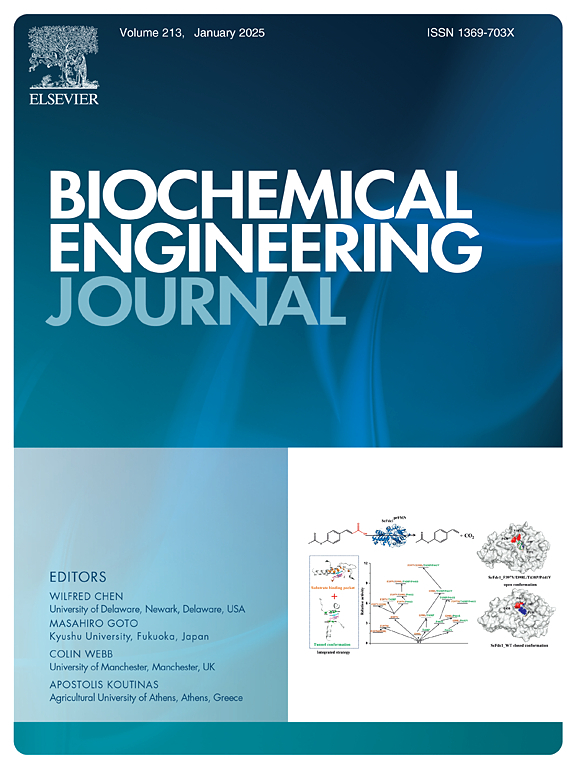体外分析 T7 RNA 聚合酶生物传感器的竞争性抑制模型
IF 3.7
3区 生物学
Q2 BIOTECHNOLOGY & APPLIED MICROBIOLOGY
引用次数: 0
摘要
T7 RNA 聚合酶(T7 RNAP)生物传感器是指 T7 RNAP 在外界刺激下转录一些报告基因或信号,它在合成生物学和代谢工程中有着广泛的应用。我们改编了一个生化反应网络模型,并利用体外转录试验确定了不同 T7 RNAP 构建物的网络参数。在限制模板 DNA 的条件下,原生和工程化 T7 RNAP 的 EC50 值从 33 nM(29-37 95 % c.i.)到 570 nM(258-714 95 % c.i.)(野生型 T7 RNAP)不等。测得的 EC50 值对游离镁、pH 值或其他缓冲条件基本不敏感。许多生物传感器配置使用的是分裂的 RNAP 构建物,其中 C 端 (CT7) 和 N 端 T7 (NT7) 与近距离诱导的二聚化模块融合。我们使用蛋白水解和离子交换色谱法制备了 CT7(80 kDa)产物。游离 CT7 对 T7 RNAP 转录活性的影响通过竞争抑制模型得到了很好的描述,传感器的抑制常数 KI = 23 nM(18-28 95 % c.i.)。这些模型参数将有助于基于 T7 RNAP 的基因回路的前瞻性建模和设计。本文章由计算机程序翻译,如有差异,请以英文原文为准。
in vitro analysis of a competitive inhibition model for T7 RNA polymerase biosensors
T7 RNA polymerase (T7 RNAP) biosensors, in which T7 RNAP transcribes some reporter gene or signal in response to external stimuli, have wide applications in synthetic biology and metabolic engineering. We adapted a biochemical reaction network model and used an in vitro transcription assay to determine network parameters for different T7 RNAP constructs. Under conditions where template DNA is limiting, the EC50 values of native and engineered T7 RNAPs ranged from 33 nM (29–37 95 % c.i.) to 570 nM (258–714 95 % c.i.) (wild-type T7 RNAP). The measured EC50 values were largely insensitive to free magnesium, pH, or other buffer conditions. Many biosensor configurations use a split RNAP construct, where the C-terminal (CT7) and N-terminal T7 (NT7) are fused to proximity induced dimerization modules. We used proteolysis and ion exchange chromatography to prepare a CT7 (80 kDa) product. The impact of free CT7 on T7 RNAP transcriptional activity was well described by a competitive inhibition model, with an inhibitory constant KI = 23 nM (18–28 95 % c.i.) of the sensor. These model parameters will be useful for forward modeling and design of T7 RNAP-based genetic circuits.
求助全文
通过发布文献求助,成功后即可免费获取论文全文。
去求助
来源期刊

Biochemical Engineering Journal
工程技术-工程:化工
CiteScore
7.10
自引率
5.10%
发文量
380
审稿时长
34 days
期刊介绍:
The Biochemical Engineering Journal aims to promote progress in the crucial chemical engineering aspects of the development of biological processes associated with everything from raw materials preparation to product recovery relevant to industries as diverse as medical/healthcare, industrial biotechnology, and environmental biotechnology.
The Journal welcomes full length original research papers, short communications, and review papers* in the following research fields:
Biocatalysis (enzyme or microbial) and biotransformations, including immobilized biocatalyst preparation and kinetics
Biosensors and Biodevices including biofabrication and novel fuel cell development
Bioseparations including scale-up and protein refolding/renaturation
Environmental Bioengineering including bioconversion, bioremediation, and microbial fuel cells
Bioreactor Systems including characterization, optimization and scale-up
Bioresources and Biorefinery Engineering including biomass conversion, biofuels, bioenergy, and optimization
Industrial Biotechnology including specialty chemicals, platform chemicals and neutraceuticals
Biomaterials and Tissue Engineering including bioartificial organs, cell encapsulation, and controlled release
Cell Culture Engineering (plant, animal or insect cells) including viral vectors, monoclonal antibodies, recombinant proteins, vaccines, and secondary metabolites
Cell Therapies and Stem Cells including pluripotent, mesenchymal and hematopoietic stem cells; immunotherapies; tissue-specific differentiation; and cryopreservation
Metabolic Engineering, Systems and Synthetic Biology including OMICS, bioinformatics, in silico biology, and metabolic flux analysis
Protein Engineering including enzyme engineering and directed evolution.
 求助内容:
求助内容: 应助结果提醒方式:
应助结果提醒方式:


